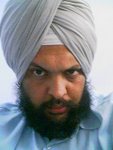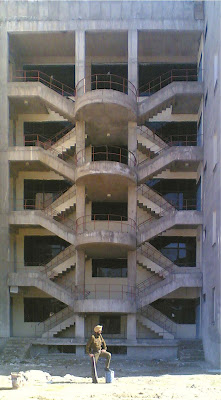This and the previous article were written for publication, could not resist posting them here. This about as much serious writing that I can do....
The practice of medicine has a history as old as that of mankind. The first healers were probably fellow hunters and gatherers or members of the community. Gradually this role became more specialized and was taken over by priests and witch doctors. However, the one fact that remained inviolate was that the healers and the patients that they treated were from the same social and cultural milieu, and therefore the problems that they presented with were healed using the resources and keeping in mind the sensibilities of that culture. This form of healing is still prevalent in primitive societies that are yet untouched by our progress. This form of medicine is characterized by a practice that is more an art than a science in that it is dependent on a patient-healer relationship and less on an understanding about what actually works in the therapeutic process.
With the growth of civilizations, each civilization derived a system of medicine that was in tune with its own sensibilities and philosophies. Keeping aside the merits and demerits of the various systems of medicines, the form of medicine that we practice today is a product of the European post-renaissance mind. This period of European history is probably the single most defining feature that shapes our world as we know it. As a result of the extraordinary freedom and ambition that this thought fostered, Europeans were able to rule over the entire world and were also able to disseminate their own philosophy and scientific temper wherever they ruled.
This growth of scientific thought though marked by various upheavals eventually crystallized itself in the principles that dominate much of modern medicine that is now called biomedicine. These principles are also called those of objectivism. These are as follows:
1. There is only one reality. By carefully dividing and studying its parts, the whole can be understood. (Realism)
2. The knower can stand outside of what is to be known. True objectivity is possible. (Positivism)
3. One event comes before another and can be said to cause that event.
4. Explanations from one time and place can be generalized to other times and places.
5. Determinism.
6. Nomothetic (search for universal laws). (Maykut and Moorehouse, 1984)
These principles imply that the truth is absolute and generalizable, is independent of the observer and the observed, and that the observer needs to be an objective dispassionate observer to get to the truth. These principles have enabled modern medicine to scale the heights it has, today we face new challenges with hope and confidence in the background of past victories and lives of millions have been saved and become better in many ways. On the other hand however, these are admirable qualities for a scientist, but when these principles are seen through the prism of medical practice, the results are quiet different. As McWhiney (1988) has put it, “Patients suffer from diseases which can be categorized in the same way as other natural phenomena. A disease can be viewed independently from the person who is suffering from it and from his or her social context. Mental and physical diseases can be considered separately. Each disease has a specific causal agent, and it is a major objective of research to discover them. Given a certain level of host resistance, the occurrence of disease can be explained as a result of exposure to a pathogenic agent. The physician’s main task is to diagnose the patient’s disease and to describe a specific remedy aimed at removing the cause or relieving the symptoms. He or she uses the clinical method known as differential diagnosis. Diseases follow a defined clinical course, subject to medical interventions. The physician is usually a detached neutral observer, whose effectiveness is independent of gender or beliefs. The patient is a passive and grateful recipient of care”. Quite obviously, a physician who follows the principles of objectivism may lose the art of healing at expense of the science of biomedicine.
In psychiatry, a major philosophical underpinning has been that of the Descartian mind-body dualism. This implies that mental processes are separate and distinct from physical or somatic processes. This seemingly innocuous statement has held sway and guided thought for over three centuries and has given rise to the notion that mental processes and more specifically mental illnesses have no physical or neural basis and it’s all, quite literally “in your mind” (Hyman, 2000). The initial school of empiricism and deep involvement as exemplified by the rich descriptions of psychopathology and nosological attempts by Jaspers, Bleuler and Kraeplin but to name a few gave way to the massive avalanche that was the Freudian thought. This gave for the first time a framework for understanding what could be observed, gave respect to personal integrity, and a less stigmatized perspective on mental illness. This understanding had no need and no place for biological systems and hence the study of the above was either neglected or even discouraged (Kandel, 1998). This model of psychiatry that held sway until recently was almost all art and little science. The model of practice and research was subjective. The therapeutic process one of cooperation and sometimes equality. Most of all, human behavior was seen as voluntary rather than deterministic.
In recent years however, there has been an apparent convergence in the philosophies of biomedicine and psychiatry. Psychiatric disorders are now viewed as requiring explanation or etiologies, diagnoses made on universal truths, and all based on the principles of objectivism. Certain robust assumptions can still be made; these being those that most of psychiatric thought today rest on:
- All mental processes are operations of the brain.
- Genes and their products are important determinants of brain function.
- Social or developmental factors influence the expression of altered genes that lead to mental illness.
- Learning can influence gene expression.
(Kandel, 1998)
If examined carefully, these statements have layers of meanings. At the very basic level is the assumption of a single universal truth regarding the universality of brain function and its psychological correlates, and the influence of genes. It also importantly, makes enough provision for the possibility of the uniqueness of human experience and learning in the etiology and progress of mental illness.
The practice of biomedicine has increasingly been subject to voices of dissatisfaction from the clinicians. This has gained momentum in the recent years with the decline of the family physician and the rise of managed care with treatment algorithms, the demise of the patient and the arrival of the case has been lamented. Response to these challenges have come about with the advent of models such as the biopsychosocial model (Engel, 1977), and the social constructivist model of medicine (Wilson, 2000) amongst others. But it is to be noted that these models have remained on the fringes of biomedical practice.
This essay aims to make a case for a return to a healthier sensitivity in the practice of biomedicine using the practice of psychiatry as a template for the same.
The following are the paradigms that are followed in psychiatric practice that have a relevance to the practice of biomedicine:
- A social and cultural context: In the search for the universal truth and in particular the truth about the nature of the disease-patients would be expected to have diseases that follow defined clinical paths. It is also worth asking whether by that standard, can an illness be considered separate from the individual who is suffering from it? Can the behavior of a disease in one patient predict how it will appear in another? Is the same disease consistent in presentation across different cultures? Or do social, cultural factors, stress, migration, affluence have a role in the causation, presentation, course and outcome of an illness. Doctors while being trained become enculturated into a particular stance of objectivism. While this may be useful for analyzing data or deductive reasoning, it may not hold true in clinical situations. Psychiatric research and practice on the other hand has had to contend with these questions as a matter of survival rather than as a matter of curiosity. This is simply because mental illness by its very nature was supposed to be an affliction of a particular class or race and hence not capable of being a universal truth. Though the matter of the existence of mental illness has been settled, this has inculcated a healthy respect for cultural and social mediators of all aspects of mental illness. Going back to Kandel’s framework, a universal truth is acted upon by many other realities that are unique to the individual and these are the prism through which the patient presents. Thus, an illness should be seen as arising from a matrix of cultural beliefs and biological systems and this interaction should be taken into account in any formulation. The doctor would also do well to be aware of personal prejudices that may be socially and culturally determined. These prejudices may influence decisions with regard to diagnosis, treatment and general demeanor.
- The primacy of the doctor-patient relationship: Day and Semrad (1978) said: “The essence of therapy with a schizophrenic patient is the interaction between the creative resources of both the therapist and the patient”. While this may not be apt in all cases of biomedicine, however it does affirm the primacy given to the relationship between the patient and the doctor. Doctors may have understandably little time or energy to spend in an effort to move away from the paternalistic mode of treatment that we follow. However it must be affirmed that doctor-patient relationship do influence outcomes, and the doctor cannot afford to remain a neutral observer of natural phenomena. Medicine has rightly prided itself on the sanctity of this relationship, but as is evident in the media and in our experience, this central fulcrum is being eroded gradually. A part of the blame must attach itself on the physician for his inability to see the patient instead of the case. As Toulmin (1993) has pointed out, “The misplaced emulation by physicians of ‘science’ is . . . the real reason why the general public is alienated from professional medicine. Inevitably and properly, the focus of the natural sciences is on the general rather than the particular, the universal rather than the existential . . ..….so instead of seeing individual subjects as ‘patients’ afflicted with various ills, biomedical scientists legitimately regard them as ‘cases’ of general syndromes or conditions; their subjects are therefore interesting only incidentally, to the extent that they exemplify some pathological entity that is interesting in itself”. His resolution is to refocus back to the original goal of medicine; to relieve suffering in the individual patient. The doctor-patient relationship is a moral exercise that guides a patient through the most significant aspects of life like birth, death, illness and healing. A way to make this change come about is ascribing to the patient the principle of voluntarism rather than following a deterministic model that reduces a patient to a physiological process. Coming back to Kandel’s framework, as has been pointed about; learning can influence protein synthesis and the doctor is at a unique position to teach or advise the patient regarding change to healthier ways of living and the importance of social support in better outcomes.
The art and science of medicine follow radically different philosophies but their eventual goals are the same. Psychiatry is a unique branch of medicine where the two have learnt to coexist most fruitfully. With a little more involvement and attention to details, physicians can expect better outcomes and if not that more satisfied patients at the very least.
References:
Day M, Semrad EV. Schizophrenic reactions. In: Nicholi AM Jr., editor. The Harvard Guide to Modern Psychiatry. Cambridge, Mass: Harvard University Press, 1978, pp 199–241.
Engel GL. The need for a new medical model: A challenge for biomedicine. Science 1977; 196(4286): 129–36.
Hyman SE. the millennium of mind, brain and behavior. Arch Gen Psy 2000; 57:88-89.
Kandel ER. A new intellectual framework for psychiatry. Am J Psy 1998; 155: 457-469.
Maykut P, Moorehouse R. Beginning Qualitative Research: A Philosophic and Practical Guide. London: Filmer Press, 1984.
McWhinney IR. A Textbook of Family Medicine. London: Oxford University Press, 1988: 46.
Toulmin S. Knowledge and art in the practice of medicine. In: Delkeskamp-Hayes C, Cutler M, editors. Science, Technology and the Art of Medicine. New York: Kluwer Academic, 1993: 234.
Wilson HJ. The myth of objectivity: is medicine moving towards a social constructivist paradigm? Family practice 2000; 17:203-209.
.jpg)
.jpg)
















+copy.jpg)





